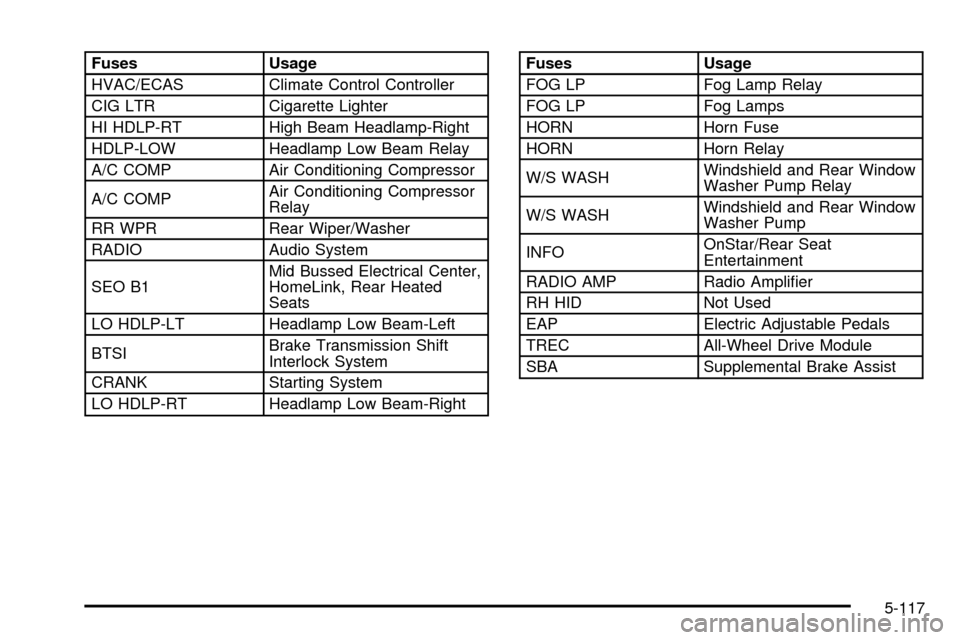2003 CHEVROLET SUBURBAN radio
[x] Cancel search: radioPage 292 of 552

For best results, use a scrubbing action, non-abrasive
cleaning cassette with pads which scrub the tape
head as the hubs of the cleaner cassette turn. The
recommended cleaning cassette is available through
your dealership.
When cleaning the cassette tape player with the
recommended non-abrasive cleaning cassette, it is
possible that the cassette may eject, because the cut
tape detection feature on your radio may recognize it as
a broken tape, in error. To prevent the cleaning
cassette from being ejected, use the following steps:
1. Turn the ignition on.
2. Turn the radio off.
3. Press and hold the TAPE DISC button for ®ve
seconds. READY will appear on the display and
the cassette symbol will ¯ash for ®ve seconds.
4. Insert the scrubbing action cleaning cassette.
5. Eject the cleaning cassette after the manufacturer's
recommended cleaning time.
When the cleaning cassette has been ejected, the cut
tape detection feature is active again.You may also choose a non-scrubbing action, wet-type
cleaner which uses a cassette with a fabric belt to
clean the tape head. This type of cleaning cassette will
not eject on its own. A non-scrubbing action cleaner
may not clean as thoroughly as the scrubbing type
cleaner. The use of a non-scrubbing action, dry-type
cleaning cassette is not recommended.
After you clean the player, press and hold the eject
button for ®ve seconds to reset the CLEAN indicator.
The radio will display --- or CLEANED to show the
indicator was reset.
Cassettes are subject to wear and the sound quality
may degrade over time. Always make sure the cassette
tape is in good condition before you have your tape
player serviced.
Care of Your CDs and DVDs
Handle discs carefully. Store them in their original cases
or other protective cases and away from direct sunlight
and dust. If the surface of a disc is soiled, dampen
a clean, soft cloth in a mild, neutral detergent solution
and clean it, wiping from the center to the edge.
Be sure never to touch the side without writing when
handling discs. Pick up discs by grasping the outer
edges or the edge of the hole and the outer edge.
3-128
Page 293 of 552

Care of Your CD and DVD Player
The use of CD lens cleaner discs is not advised, due to
the risk of contaminating the lens of the CD optics
with lubricants internal to the CD mechanism.
Cleaning the Video Screen
Pour some isopropyl or rubbing alcohol on a clean cloth
and gently wipe the video screen. Do not spray
directly onto the screen and do not press too hard or
too long on the video screen.
Fixed Mast Antenna
The ®xed mast antenna can withstand most car washes
without being damaged. If the mast should ever
become slightly bent, you can straighten it out by hand.
If the mast is badly bent, as it might be by vandals,
you should replace it.
Check occasionally to be sure the mast is still tightened
to the cowl. If tightening is required, tighten by hand,
then with a wrench one quarter turn.
XMŸ Satellite Radio Antenna
System (48 Contiguous US States)
Your XMŸ Satellite Radio antenna is located on the roof
of your vehicle. Keep this antenna clear of snow and
ice build up for clear radio reception.
The performance of your XMŸ system may be affected
if your sunroof is open.
Loading items onto the roof of your vehicle can interfere
with the performance of your XMŸ system. Make
sure that the XMŸ satellite antenna is not obstructed.
Chime Level Adjustment
The radio is the vehicle chime producer. To change the
volume level, press and hold pushbutton 6 with the
ignition on and the radio power off. The chime volume
level will change from the normal level to loud, and LOUD
will be displayed on the radio. To change back to the
default or normal setting, press and hold pushbutton 6
again. The chime level will change from the loud level to
normal, and NORMAL will be displayed. Each time the
chime volume is changed, three chimes will sound as an
example of the new volume selected. Removing the radio
and not replacing it with a factory radio or chime module
will disable vehicle chimes.
3-129
Page 426 of 552

2. Get the vehicles close enough so the jumper cables
can reach, but be sure the vehicles aren't touching
each other. If they are, it could cause a ground
connection you don't want. You wouldn't be able to
start your vehicle, and the bad grounding could
damage the electrical systems.
To avoid the possibility of the vehicles rolling, set
the parking brake ®rmly on both vehicles involved in
the jump start procedure. Put the automatic
transmission in PARK (P) before setting the parking
brake. If you have a four-wheel-drive vehicle, be
sure the transfer case is in a drive gear not in
NEUTRAL.
Notice:If you leave your radio on, it could be badly
damaged. The repairs wouldn't be covered by
your warranty.
3. Turn off the ignition on both vehicles. Unplug
unnecessary accessories plugged into the cigarette
lighter or in the accessory power outlets. Turn off
the radio and all the lamps that aren't needed. This
will avoid sparks and help save both batteries.
And it could save your radio!4. Open the hoods and locate the positive (+) and
negative (-) terminal locations of the other vehicle.
Your vehicle has a remote positive (+) jump
starting terminal and a remote negative (-) jump
starting terminal. You should always use these
remote terminals instead of the terminals on the
battery.
The remote positive (+) terminal is located behind a
red plastic cover near the engine accessory drive
bracket. To uncover the remote positive (+) terminal,
open the red plastic cover.
The remote negative (-) terminal is located on the
engine drive bracket, or on the thermostat
housing on the 8.1L engine. It is marked²GND.²
See
Engine Compartment Overview on page 5-14for more information on location.
5-50
Page 485 of 552

Fuses and Circuit Breakers
The wiring circuits in your vehicle are protected from
short circuits by a combination of fuses, circuit breakers
and fusible thermal links. This greatly reduces the
chance of ®res caused by electrical problems.
Look at the silver-colored band inside the fuse. If the
band is broken or melted, replace the fuse. Be sure you
replace a bad fuse with a new one of the identical
size and rating.
If you ever have a problem on the road and don't have
a spare fuse, you can borrow one that has the same
amperage. Just pick some feature of your vehicle
that you can get along without ± like the radio or
cigarette lighter ± and use its fuse, if it is the correct
amperage. Replace it as soon as you can.
Instrument Panel Fuse Block
The fuse block access
door is on the driver's side
edge of the instrument
panel. Pull off the cover to
access the fuse block.
To remove fuses, hold the end of the fuse between your
thumb and index ®nger and pull straight out.
You may have spare fuses located behind the fuse
block access door. These can be used to replace a bad
fuse. However, make sure it is of the correct amperage.
5-109
Page 493 of 552

Fuses Usage
HVAC/ECAS Climate Control Controller
CIG LTR Cigarette Lighter
HI HDLP-RT High Beam Headlamp-Right
HDLP-LOW Headlamp Low Beam Relay
A/C COMP Air Conditioning Compressor
A/C COMPAir Conditioning Compressor
Relay
RR WPR Rear Wiper/Washer
RADIO Audio System
SEO B1Mid Bussed Electrical Center,
HomeLink, Rear Heated
Seats
LO HDLP-LT Headlamp Low Beam-Left
BTSIBrake Transmission Shift
Interlock System
CRANK Starting System
LO HDLP-RT Headlamp Low Beam-RightFuses Usage
FOG LP Fog Lamp Relay
FOG LP Fog Lamps
HORN Horn Fuse
HORN Horn Relay
W/S WASHWindshield and Rear Window
Washer Pump Relay
W/S WASHWindshield and Rear Window
Washer Pump
INFOOnStar/Rear Seat
Entertainment
RADIO AMP Radio Ampli®er
RH HID Not Used
EAP Electric Adjustable Pedals
TREC All-Wheel Drive Module
SBA Supplemental Brake Assist
5-117
Page 533 of 552

A
Accessory Power Outlets.................................3-19
Adding Washer Fluid.......................................5-44
Additional Program Information........................... 7-9
Additives, Fuel................................................. 5-6
Add-On Electrical Equipment...........................5-108
Adjustable Throttle and Brake Pedal..................2-24
Adjusting the Speakers (Balance/Fade).....3-75, 3-79,
3-90, 3-104
After Off-Road Driving.....................................4-40
Air Bag Systems.....................................1-73, 1-80
Adding Equipment to Your Air Bag-Equipped
Vehicle...................................................1-88
How Does an Air Bag Restrain?....................1-80
Passenger Sensing System...........................1-83
Servicing Your Air Bag-Equipped Vehicle.........1-87
What Makes an Air Bag In¯ate?....................1-80
What Will You See After an Air Bag In¯ates?......1-81
When Should an Air Bag In¯ate?...................1-79
Where Are the Air Bags?..............................1-76
Air Bag .........................................................3-39
Passenger Status Indicator...........................3-39
Readiness Light..........................................3-39
Air Cleaner/Filter, Engine.................................5-23
Air Conditioning..............................................3-28
All-Wheel Drive with Stabilitrak
ž........................2-34All-Wheel Drive...............................................5-55
AM-FM Radio.................................................3-73
AM .............................................................3-127
Antenna, Fixed Mast......................................3-129
Antenna, XMŸ Satellite Radio
Antenna System........................................3-129
Anti-Lock Brake, System Warning Light..............3-44
Anti-lock Brake System..................................... 4-7
Appearance Care............................................5-99
Care of Safety Belts...................................5-102
Chemical Paint Spotting..............................5-105
Cleaning the Inside of Your Vehicle................5-99
Cleaning the Outside of Your Vehicle............5-102
Finish Damage..........................................5-104
Sheet Metal Damage..................................5-104
Underbody Maintenance.............................5-105
Vehicle Care/Appearance Materials...............5-105
Weatherstrips............................................5-102
Approaching a Hill..........................................4-30
Ashtrays........................................................3-20
Audio Output................................................3-121
Audio System(s).............................................3-72
AM-FM Radio.............................................3-73
Audio Steering Wheel Controls....................3-126
Care of Your Cassette Tape Player...............3-127
Care of Your CD and DVD Player................3-129
1
Page 534 of 552

Audio System(s) (cont.)
Care of Your CDs and DVDs.......................3-128
Chime Level Adjustment.............................3-129
Fixed Mast Antenna...................................3-129
Radio with Cassette and CD.........................3-87
Radio with CD............................................3-76
Radio with Six-Disc CD..............................3-101
Rear Seat Audio (RSA)...............................3-124
Setting the Time for Radios with Radio Data
Systems (RDS)........................................3-73
Setting the Time for Radios without Radio
Data Systems (RDS)................................3-72
Theft-Deterrent Feature...............................3-125
Understanding Radio Reception...................3-127
XMŸ Satellite Radio Antenna System...........3-129
Automatic Headlamp System............................3-15
Automatic Level Control...................................4-64
Automatic Transfer Case..................................2-30
Automatic Transmission Check..........................6-12
Automatic Transmission Shift Lock Control
System Check.............................................6-14
Automatic Transmission...................................5-26
Fluid..........................................................5-26
Operation...................................................2-26
AutorideŸ.....................................................4-64
Auxiliary Roof Mounted Lamp Switch.................3-17B
Backing Up....................................................4-74
BATTERY NOT CHARGING.............................3-65
Battery Replacement......................................... 2-6
Battery Run-Down Protection............................3-19
Battery Warning Light......................................3-41
Battery..........................................................5-48
Before Leaving on a Long Trip.........................4-47
Before You Drive...........................................3-114
Before You Go Off-Roading..............................4-25
Bench Seat Split (50/50)..................................1-12
Bench Seat, Split (60/40)................................... 1-9
Bench Seat....................................................1-16
Body Lubrication Service..................................6-13
Brake............................................................2-38
Parking......................................................2-38
System Inspection.......................................6-17
System Warning Light..................................3-42
Brake Adjustment............................................5-48
Brake Fluid....................................................5-45
Brake Pedal, Throttle.......................................2-24
Brake Pedal Travel.........................................5-48
Brake Wear...................................................5-47
Brakes..........................................................5-45
Braking in Emergencies..................................... 4-9
2
Page 545 of 552

Park(P).........................................................2-39
Shifting Into................................................2-39
Part A - Scheduled Maintenance Services............ 6-4
Part B - Owner Checks and Services................6-11
Part C - Periodic MaintenanceInspections..........6-16
Part D - Recommended Fluids and Lubricants....6-18
Part E - Maintenance Record...........................6-20
Passenger Air Bag Indicator.....................2-48, 2-51
Passenger Air Bag Status Indicator...................3-39
PASSENGER DOOR AJAR..............................3-67
Passenger Sensing System..............................1-83
Passing.................................................4-20, 4-74
Passlock
ž......................................................2-20 .
Personalization Button.....................................3-58
Plan Ahead When Possible................................ 7-8
Playing a Cassette Tape..................................3-96
Playing a Compact Disc.................3-85, 3-98, 3-109
Playing a Speci®c Loaded Compact Disc..........3-110
Playing the Radio.................3-73, 3-77, 3-88, 3-102
Power Steering...............................................4-15
Power Winches..............................................4-81
Power...........................................................3-19
Accessory Outlets........................................3-19
Door Locks.................................................. 2-9
Electrical System.......................................5-108Power (cont.)
Lumbar Controls........................................... 1-5
Seat............................................................ 1-4
Steering Fluid.............................................5-43
Windows....................................................2-16
Programmable Automatic Door Locks.................2-10
Programming the HomeLink Transmitter.............2-58
Q
QUADRASTEERŸ..........................................4-17
Questions and Answers About Safety Belts.........1-28
R
Radio Data System (RDS)..............3-76, 3-87, 3-101
Radio Messages.............................3-75, 3-82, 3-93
Radios..........................................................3-72
AM-FM Radio.............................................3-73
Care of Your Cassette Tape Player...............3-127
Care of Your CD and DVD Player................3-129
Care of Your CDs and DVDs.......................3-128
Radio with Cassette and CD.........................3-87
Radio with CD............................................3-76
13